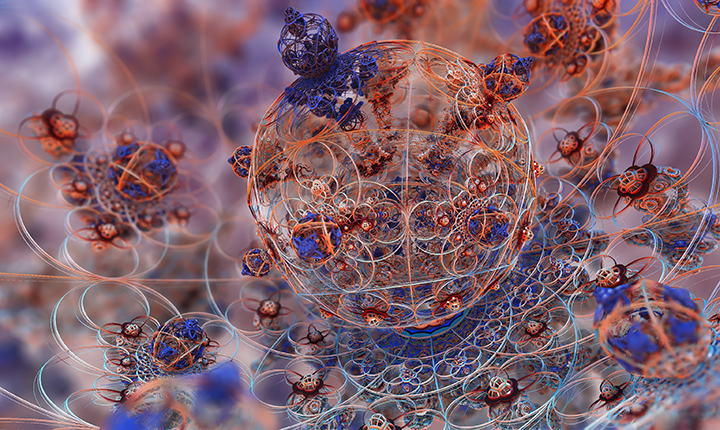Chaos is a loaded word. Nuances of difference in common usage, mathematics, religion, science, and philosophy are inherent in the term. This article will discuss the possible origins of chaos and how it shapes our reality from both a metaphysical and scientific viewpoint.
DEFINITION
In common usage, chaos denotes random disorganization. Chaos theory has a somewhat different premise. Chaos is the study of how the unpredictable arises from the predictable. Its unpredictable behavior derives from great sensitivity to small changes in its initially predictable conditions. Great differences in outcome result from slight differences in initial conditions so the future becomes a blur. This means the future cannot be foretold with accuracy in chaotic systems. Chaos is not exactly random. It does overlap with order—up to a certain point.
INTRODUCTION
We are the product of other dimensions of existence—many scientists are coming to believe this—but science is limited to the materially observable. I always like to begin at the beginning and look at the roots of any subject. The material world appeared from the unobservable to the observable. This necessitates an examination beyond physics meaning metaphysical or spiritual. I believe consciousness is the root of our reality and chaos is an aspect of that consciousness. The most advanced concept of the creation, in my opinion, is found within the philosophical streams of Neo-Platonism and a related ancient wisdom tradition called Gnosticism. The Gnostic creation story is a virtual analog to modern scientific theory.
Gnosticism was a marriage between Eastern and Western traditions—Hellenistic philosophy, Hermeticism, and Jewish mysticism with ancient Eastern traditions such as Hinduism and Zoroastrianism. Baptized in the powerful intellectual waters of Alexandria, Egypt, Gnosticism predated Christianity but became the mystical branch of the early Christian Church. Though eradicated as heresy by the more dogmatic orthodox branch of Christianity, Gnosticism exerted tremendous effects on the Christian religion for many centuries. As mentioned, I found the Gnostic creation story to read like an ancient primer on major theories of quantum physics, so let’s begin there.
THE CREATION OF ORDER
Everything began with the One or Source Consciousness. Through the action of its internal polarities that were described as male and female forces or yin and yang in Eastern terminology, the One generated other conscious beings called Aeons or Eternities. The Aeons were actually the archetypes of existence with names like Truth, Love, and Wisdom. The Aeonic creations were not simultaneous. They were formed by a specific repetitive process, a feedback loop routine. Each Aeon had to loop back to the Whole for the energy to produce a new Aeon. This means the parts (Aeons) required the Source’s Consciousness or Energy for an orderly co-creative process. This stands to reason. The Source, after all, was the birthing creative force of everything to begin with. Like successive copies of a CD where new copies have slightly less fidelity than the one preceding it, each successive Aeon contained slightly less vibration possessing lower consciousness than its predecessor. What’s important here, however, is that each Aeon had to go back to the Source Consciousness to derive “consent” to create. This feedback loop of creation is a recursive process. It is a repetitive process in which the parts require the whole to produce new forms. Remember the term. It plays an important role in our story.
THE ORIGINS OF CHAOS
The Source and its Aeonic creations collectively populated a dimension of perfect harmony and order called the Pleroma or the Fullness. But outside the Fullness lay a shadow called chaos. Chaos was an unformed area of potential left unorganized by the Mind of the One. But why would such a thing exist? It gets a bit complicated here. The answer is implicit rather than explicit in the texts. The One created the Aeons to be independent beings to share in the creation. They knew themselves to be themselves but also knew that they were part of the Source. To be an independent being requires free will, otherwise, they would never be independent parts of the Whole but mindless mirror reflections.
Free will requires choice. True individuality cannot exist without it. But the Source dimension or Fullness was characterized by a harmony in which the Aeons used their free will to be in sync with the One. To exert one’s own will independent of the One was impossible in the Fullness, so where could independent beings assert their own will? It seems that the Source allowed a place for individuality to run its potential course. The paradox was solved by the existence of chaos, an unformed, unorganized dimension of potential existence set apart and described as a shadow outside of heaven or the Fullness.
One of the Aeons called Sophia (Gr. for Wisdom) decided to exert her will independent of the One and the co-creative process described above. She plunged her consciousness into Chaos. Now begins some very interesting intersections with modern science. We often picture chaos as a random void, but science has shown that no voids exist. Even in vacuums, seemingly empty space seethes with virtual particles of random potential to become material.
The high energy of Sophia’s contact with Chaos activated the virtual particles (called “proto-matter” in the texts). To make a very long story short, all this activity leads to the formation of matter and the material world, a dimension where consciousness struggles to organize itself in a sea of random impermanence. In the next part, we’ll move from the metaphysical to chaos in our experience of everyday reality.
Peter Canova
The author of the 25 X award-winning First Souls Trilogy and has contributed to the popular Chicken Soup for the Soul series. His latest publication, Quantum Spirituality, received 4 titles in The American Book Fest’s 2023 Best Book Awards.
https://www.petercanova.com/




